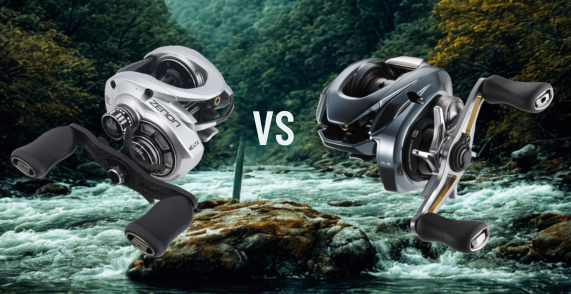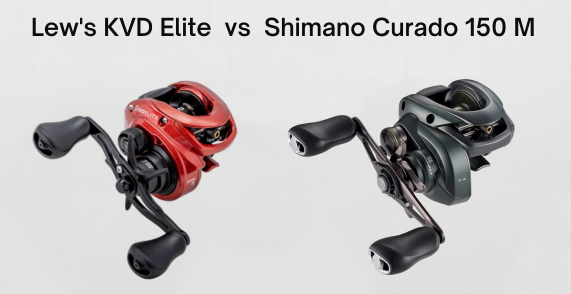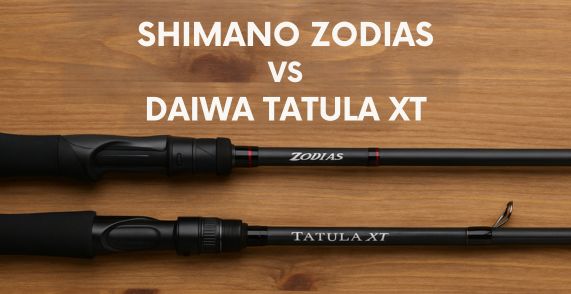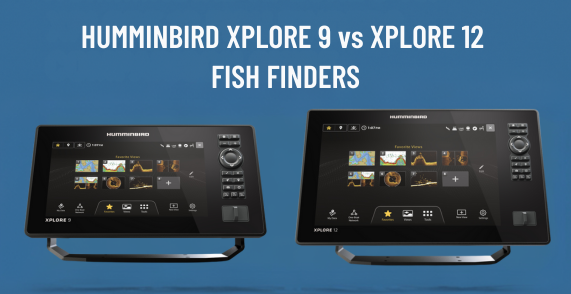In This Post
- 1 Key Takeaways
- 2 Two Premium BFS Reels Battle for Ultra-Light Supremacy
- 3 Weight and Construction: Matched at 4.6 Ounces
- 4 Braking Systems: FTB vs IVCB-4 Technology
- 5 Spool Design: MGL III vs SLC Technology
- 6 Drag Power: 11 Pounds vs 8 Pounds Maximum
- 7 Casting Performance: Which Dominates Ultra-Light Lures
- 8 Choose Aldebaran for Pure Finesse, Zenon for Power Versatility
Key Takeaways
- Weight advantage: The Abu Garcia Zenon MG-LTX weighs 4.6 ounces versus the Shimano Aldebaran BFS at 4.6 ounces, with both representing the pinnacle of ultra-light BFS construction
- Braking technology: Shimano’s FTB system moves all braking components off the spool for minimal start-up inertia, while Abu Garcia’s IVCB-4 offers precise centrifugal adjustment for versatile casting control
- Casting performance: The Aldebaran BFS excels with 1-2 gram ultra-light lures thanks to its ultra-light MGL Spool III, while the Zenon MG-LTX delivers 38% more drag power (11 vs 8 pounds) for versatility beyond pure finesse
- Target application: Choose the Shimano for dedicated ultra-light finesse fishing or the Abu Garcia for power versatility across broader BFS applications
- Advanced spool engineering: Both reels employ cutting-edge technologies that redefine what’s possible in bait finesse casting performance
When serious anglers invest in premium bait finesse system (BFS) equipment, two reels consistently dominate the conversation: the Abu Garcia Zenon MG-LTX and the Shimano Aldebaran BFS.
Both represent the absolute pinnacle of ultra-light baitcasting technology, engineered specifically for launching lures that traditionally belonged in spinning gear territory.
Two Premium BFS Reels Battle for Ultra-Light Supremacy
The BFS revolution transformed finesse fishing by enabling baitcasters to handle lures as light as 1-2 grams with precision and distance previously impossible.
This Japanese-originated technique demands reels engineered with obsessive attention to weight reduction, friction minimization, and start-up inertia elimination.
Both the Zenon MG-LTX and Aldebaran BFS answer this call, but through distinctly different engineering philosophies.
The fundamental distinction lies in their approach to the core BFS challenge: how to achieve maximum casting distance with minimal lure weight.
Shimano prioritizes absolute minimal start-up inertia through brake system relocation, while Abu Garcia emphasizes precise adjustability and casting stability through advanced centrifugal control.
these philosophical differences proves vital for selecting the right tool for specific fishing applications.
Both reels occupy the premium tier with pricing reflecting their specialized engineering—the Zenon MG-LTX typically retails for $550-650, while the Aldebaran BFS commands $500-600.
The marginal price difference means the decision ultimately comes down to technical performance characteristics rather than budget considerations.
Weight and Construction: Matched at 4.6 Ounces
4.6 vs 4.6 Ounces: Frame Materials and Engineering Philosophy
Both reels achieve identical 4.6-ounce (130g) weights, yet this achievement represents the absolute limits of current reel engineering through different material strategies.
The Abu Garcia Zenon MG-LTX achieves its weight through a sophisticated multi-material approach: a one-piece X-Mag alloy frame paired with C6 carbon sideplates.
This hybrid construction strategy deploys lightweight composites where structural loads are minimal while maintaining metal alloy strength where it matters most.
The Shimano Aldebaran BFS reaches the same weight using a different materials philosophy. Its Hagane body construction utilizes magnesium for the frame, providing exceptional rigidity-to-weight ratio vital for maintaining gear alignment under pressure.
The CI4+ carbon integration complements the magnesium foundation, creating a chassis that prioritizes long-term precision over marginal weight savings.
Both approaches achieve their ultra-light status while maintaining structural integrity, but the material choices reveal different priorities.
Abu Garcia’s X-Mag alloy and carbon combination emphasizes absolute weight reduction, while Shimano’s magnesium-based Hagane construction prioritizes dimensional stability and manufacturing precision that translates to smoother long-term operation.
Bearing Systems and Gear Ratio Options
The bearing systems reflect each manufacturer’s precision engineering approach. The Zenon MG-LTX incorporates 10 total bearings: 9 stainless steel HPCR bearings plus 1 roller bearing, supplemented by CeramiLite spool bearings.
This bearing system focuses on friction elimination throughout the drivetrain, with hybrid ceramic spool bearings specifically targeting casting performance.
The Aldebaran BFS utilizes 10+1 S-ARB (Super Anti-Rust Bearings), Shimano’s proprietary bearing technology renowned for corrosion resistance and operational smoothness.
The S-ARB system prioritizes consistent performance across varied environmental conditions, particularly important for saltwater or high-humidity applications where bearing integrity directly impacts reel longevity.
Gear ratio options reveal different market positioning strategies. The Zenon MG-LTX offers a single 8.3:1 ratio providing 31 inches per turn, emphasizing speed for quick line retrieval.
The Aldebaran BFS provides two choices: 7.8:1 (HG) delivering 30 inches per turn and 8.9:1 (XG) providing 32 inches per turn. This versatility allows anglers to match retrieval speed to specific techniques and fishing conditions.
Braking Systems: FTB vs IVCB-4 Technology
Shimano’s Magnetic FTB System
The Finesse Tune Brake (FTB) system represents Shimano’s most significant BFS advancement. Unlike traditional braking systems that operate on or near the spool, the FTB completely relocates all braking components to the palm-side sideplate.
This architectural decision eliminates brake mass from the rotating assembly, dramatically reducing start-up inertia—the force required to initiate spool rotation.
The FTB operates through dynamic magnetic adjustment, automatically modifying braking force based on spool speed. During the initial casting phase when spool RPMs are highest, maximum magnetic braking prevents backlash.
As the lure loses momentum and spool speed decreases, the brake automatically retracts, allowing near-zero resistance for maximum distance. This automatic modulation makes the system particularly forgiving for anglers learning BFS techniques while maintaining expert-level performance.
The external dial provides continuous adjustment, with the option to add or remove magnetic units for custom tuning.
This system excels with ultra-light lures in the 1-2 gram range, where traditional braking systems often struggle to provide adequate control without killing casting distance.
Abu Garcia’s Centrifugal IVCB-4 Control
The IVCB-4 (Infinitely Variable Centrifugal Brake) system represents Abu Garcia’s advanced evolution of centrifugal braking technology.
This system utilizes adjustable brake blocks mounted on the spool that extend outward via centrifugal force during casting, making contact with a brake track.
The natural physics of centrifugal force means maximum braking occurs during high-speed spool rotation, tapering off as the spool slows.
The “variable” designation refers to the external adjustment capability, allowing continuous brake force modification without internal disassembly.
This real-time adjustability proves valuable when conditions change—switching between different lure weights, adapting to wind conditions, or fine-tuning for different casting techniques within the same fishing session.
Centrifugal systems traditionally excel with aggressive casting styles that generate high initial spool speeds.
The IVCB-4’s advanced design maintains this strength while extending usability into lighter lure categories through precise brake force control and premium friction materials.
Performance Impact on Ultra-Light Casting
The braking system choice fundamentally determines casting character and optimal lure weight range.
Field testing consistently demonstrates the Aldebaran BFS’s superiority with ultra-light presentations below 2 grams, where its FTB system’s minimal start-up inertia provides effortless launching. The automatic brake modulation forgives subtle casting inconsistencies while maximizing distance potential.
The Zenon MG-LTX’s IVCB-4 system shines with slightly heavier BFS lures and variable casting conditions. Its precise adjustability allows exact tuning for different scenarios within a single fishing session.
Anglers who prefer aggressive casting techniques or fish in windy conditions often prefer the predictable, tunable nature of advanced centrifugal control.
Spool Design: MGL III vs SLC Technology
Shimano’s MGL Spool III Innovation
The MagnumLite (MGL) Spool III represents Shimano’s most advanced spool engineering, achieving what the company describes as their lightest spool design. This 29mm diameter spool combines aluminum construction with strategic weight reduction through precision machining and material optimization.
The reduced mass translates directly to lower rotational inertia, enabling casting of lures as light as 1-2 grams with remarkable ease.
The MGL III incorporates SilentTune technology for perfect spool centering, eliminating wobble that can affect casting accuracy and distance.
This precision centering becomes critical with ultra-light lures where even minor irregularities significantly impact performance.
The shallow spool design provides 6-8lb fluorocarbon capacity of 45 meters, optimized specifically for finesse applications where minimal line capacity actually improves spool performance characteristics.
Abu Garcia’s Super Lightweight Concept
The Super Lightweight Concept (SLC) spool design emphasizes friction reduction through hybrid ceramic bearing integration directly into the spool assembly.
These CeramiLite bearings reduce friction during casting, allowing the spool to maintain rotational speed longer once initiated. The Infini II spool technology incorporates precision balancing and advanced materials for consistent performance.
Unlike the Aldebaran’s dedicated ultra-light focus, the SLC spool maintains substantial line capacity: 20lb braid for 145 meters or 10lb mono for 135 meters.
This capacity versatility enables the Zenon to function beyond pure finesse applications, handling slightly larger presentations while retaining BFS capability.
The trade-off involves slightly higher spool mass compared to Shimano’s ultra-minimal approach, but gains versatility for anglers who want one reel for multiple techniques.
Drag Power: 11 Pounds vs 8 Pounds Maximum
Why Abu Garcia Delivers 38% More Drag Force
The drag capacity difference reveals distinct design philosophies regarding BFS applications.
The Abu Garcia Zenon MG-LTX provides 11 pounds maximum drag, while the Shimano Aldebaran BFS offers 8 pounds (3.5kg).
This 38% difference in drag power reflects Abu Garcia’s vision of BFS versatility extending beyond ultra-light presentations to include scenarios where more stopping power becomes necessary.
Both systems utilize carbon drag washers for smooth, consistent performance, but the Zenon’s higher capacity enables targeting larger species or fishing around heavy cover where additional drag authority proves valuable.
This extra power comes without significant weight penalty, demonstrating sophisticated engineering in the drag stack design and materials selection.
The Aldebaran’s 8-pound capacity aligns with pure finesse fishing philosophy, providing adequate power for typical BFS targets while maintaining the ultra-light character needed for optimal casting performance.
The system includes Shimano’s Exciting Drag Sound feature, providing audible feedback during fish runs similar to spinning reel operation.
Build Quality and Manufacturing Precision
Manufacturing precision becomes critical in ultra-light reels where tolerances directly impact performance and longevity.
The Aldebaran BFS benefits from Shimano’s legendary precision manufacturing, incorporating MicroModule Gear II technology that increases gear teeth count for smoother engagement and reduced mechanical noise.
The X-SHIP gear support system maintains perfect gear alignment under load, ensuring consistent performance throughout the reel’s service life.
The Zenon MG-LTX features AMG2 fully machined aluminum main gears designed for durability, paired with Hyper Smooth Transmission technology.
While both reels achieve smooth operation, the Aldebaran’s MicroModule technology often sets industry standards for vibrational damping and operational refinement, particularly important for detecting subtle strikes during finesse presentations.
Casting Performance: Which Dominates Ultra-Light Lures
1-2 Gram Lure Casting Comparison
Real-world casting performance with ultra-light lures reveals the practical implications of each reel’s engineering approach. The Shimano Aldebaran BFS consistently demonstrates superior performance with lures at or below 2 grams, where its FTB system and ultra-light spool create effortless casting characteristics.
Anglers report being able to cast 1/16 ounce lures farther with the Aldebaran than 3/8 ounce lures on conventional gear, demonstrating the effectiveness of minimal start-up inertia design.
The mechanical advantage of relocating brake components away from the spool becomes most apparent in this ultra-light category.
The reduced rotational mass allows even gentle casting motions to achieve impressive distances, making the technique more accessible to anglers developing their BFS skills while maintaining expert-level capabilities.
Distance Testing and Real-World Results
Controlled casting battles reveal interesting performance characteristics across different lure weights.
Despite having equivalent spool mass, the Abu Garcia Zenon MG-LTX has outperformed the Aldebaran BFS in average casting distance tests with slightly heavier BFS lures.
This advantage stems from the IVCB-4 system’s stability and the SLC spool’s momentum retention capabilities once rotation is established.
However, the Zenon struggles with the absolute lightest presentations where start-up inertia becomes the limiting factor.
The Aldebaran’s engineering specifically targets this challenge, making it the clear choice for anglers focused on ultra-light applications. The automatic brake adjustment also provides more consistent results across varying casting techniques and environmental conditions.
Wind performance adds another dimension to the comparison.
The Zenon’s adjustable IVCB-4 system allows real-time adaptation to changing conditions, while the Aldebaran’s FTB system maintains more consistent performance but with less on-the-fly adjustment capability.
Choose Aldebaran for Pure Finesse, Zenon for Power Versatility
The decision between these premium BFS reels ultimately depends on fishing style and primary applications.
The Shimano Aldebaran BFS represents the pinnacle of specialized ultra-light casting technology, engineered specifically for presentations in the 1-5 gram range.
Its FTB system, ultra-light MGL Spool III, and precision manufacturing create an unmatched platform for pure finesse applications like pressured bass scenarios, mountain stream trout fishing, and technical presentations where casting distance with minimal weights determines success.
The Abu Garcia Zenon MG-LTX serves as an excellent hybrid BFS platform, bridging the gap between traditional baitcasting and ultra-light finesse fishing.
Its higher drag capacity, substantial line capacity, and adjustable braking make it ideal for anglers who want versatility to handle both finesse presentations and slightly larger lures within the same fishing session.
The IVCB-4 system’s adaptability to changing conditions and lure weights provides practical advantages for dynamic fishing scenarios.
For dedicated finesse specialists targeting ultra-light presentations, the Aldebaran BFS offers superior casting ease and distance with minimal weights.
For versatile anglers who want one premium reel capable of spanning finesse and power finesse applications, the Zenon MG-LTX provides broader capability while maintaining excellent BFS performance.
Both represent the absolute pinnacle of current BFS technology, with the choice depending on intended applications rather than overall quality.







